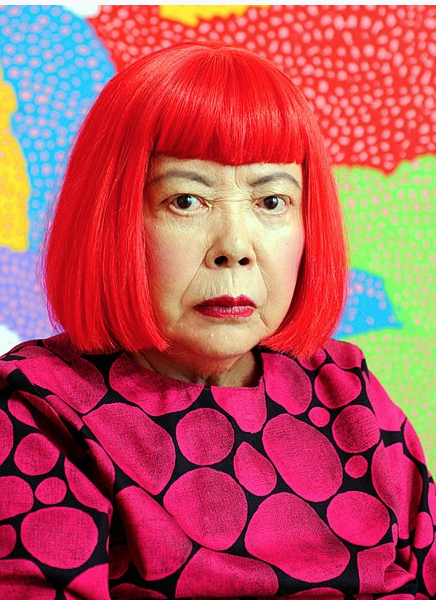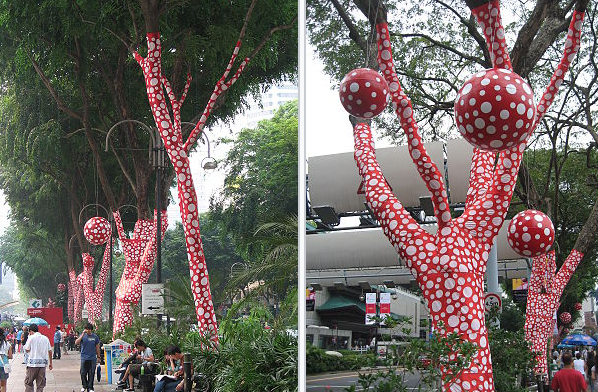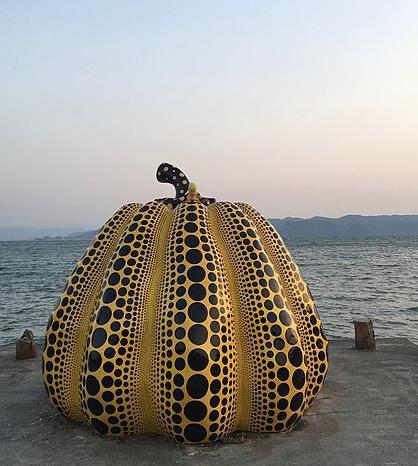Who ART You? 14
This artist is one of the most fascinating and creative women I’ve ever seen. Her story is deep and emotional, and a testament that you aren’t a product of your past and the future is whatever you make it. I am completely wowed by Yayoi Kusama and I know you will be too!
Yayoi Kusama
Who ART You?
From wikipedia:
This is a long read but ohhhh, so worth it!
Yayoi Kusama (草間 彌生 Kusama Yayoi, born 22 March 1929) is a Japanese contemporary artist who works primarily in sculpture and installation, but is also active in painting, performance, film, fashion, poetry, fiction, and other arts. Her work is based in conceptual artand shows some attributes of feminism, minimalism, surrealism, Art Brut, pop art, and abstract expressionism, and is infused with autobiographical, psychological, and sexual content. She has been acknowledged as one of the most important living artists to come out of Japan.
Raised in Matsumoto, Kusama trained at the Kyoto School of Arts and Crafts in a traditional Japanese painting style called nihonga. Kusama was inspired, however, by American Abstract Impressionism. She moved to New York City in 1958 and was a part of the New York avant-garde scene throughout the 1960s, especially in the pop-art movement. Embracing the rise of the hippie counterculture of the late 1960s, she came to public attention when she organized a series of happenings in which naked participants were painted with brightly colored polka dots. Since the 1970s, Kusama has continued to create art, most notably installations in various museums around the world.
New York City: 1957–1972
After living in Tokyo and France, Kusama left Japan at the age of 27 for the United States. She has stated that she began to consider Japanese society "too small, too servile, too feudalistic, and too scornful of women." In 1957, she moved to Seattle, where she had an exhibition of paintings at the Zoe Dusanne Gallery. She stayed there for a year before moving on to New York City, following correspondence with Georgia O'Keeffe in which she professed an interest in joining the limelight of the city, and sought O'Keeffe's advice. During her time in the US, she quickly established her reputation as a leader in the avant-garde movement and received praise for her work from the anarchist art critic Herbert Read. In 1961 she moved her studio into the same building as Donald Judd and sculptor Eva Hesse; Hesse became a close friend. In the early 1960s Kusama began to cover items such as ladders, shoes and chairs with white phallic protrusions.Despite the micromanaged intricacy of the drawings, she turned them out fast and in bulk, establishing a rhythm of productivity which she still maintains. She established other habits too, like having herself routinely photographed with new work and regularly appearing in public wearing her signature bobbed wigs and colorful, avant-garde fashions.
A polka-dot has the form of the sun, which is a symbol of the energy of the whole world and our living life, and also the form of the moon, which is calm. Round, soft, colorful, senseless and unknowing. Polka-dots become movement ... Polka dots are a way to infinity.
Since 1963, Kusama has continued her series of Mirror/Infinity rooms. In these complex infinity mirror installations, purpose-built rooms lined with mirrored glass contain scores of neon-colored balls, hanging at various heights above the viewer. Standing inside on a small platform, an observer sees light repeatedly reflected off the mirrored surfaces to create the illusion of a never-ending space. During the following years, Kusama was enormously productive, and by 1966 she was experimenting with room-size, freestanding installations that incorporated mirrors, lights, and piped-in music. She counted Judd and Joseph Cornell among her friends and supporters. However, she did not profit financially from her work. Around this time, Kusama was hospitalized regularly from overwork, and O'Keeffe convinced her own dealer Edith Herbert to purchase several works in order to help Kusama stave off financial hardship.
In the 1960s, Kusama organized outlandish happenings in conspicuous spots like Central Park and the Brooklyn Bridge, often involving nudity and designed to protest the Vietnam War. In one, she wrote an open letter to Richard Nixon offering to have sex with him if he would stop the Vietnam war. Between 1967 and 1969 she concentrated on performances held with the maximum publicity, usually involving Kusama painting polka dots on her naked performers, as in the Grand Orgy to Awaken the Dead at the MoMA (1969), which took place at the Sculpture Garden of the Museum of Modern Art. During the unannounced event, eight performers under Kusama's direction removed their clothing, stepped nude into a fountain, and assumed poses mimicking the nearby sculptures by Picasso, Giacometti, and Maillol.
In 1968, Kusama presided over the happening Homosexual Wedding at the Church of Self-obliteration at 33 Walker Street in New York and performed alongside Fleetwood Mac and Country Joe and the Fish at the Fillmore East in New York City. She opened naked painting studios and a gay social club called the Kusama 'Omophile Kompany (kok).
In 1966, Kusama first participated in the Venice Biennale for its 33rd edition. Her Narcissus Garden comprised hundreds of mirrored spheres outdoors in what she called a "kinetic carpet". As soon as the piece was installed on a lawn outside the Italian pavilion, Kusama, dressed in a golden kimono, began selling each individual sphere for 1,200 lire (US$2), until the Biennale organizers put an end to her enterprise. Narcissus Garden was as much about the promotion of the artist through the media as it was an opportunity to offer a critique of the mechanization and commodification of the art market.
During her time in New York, Kusama had a brief relationship with artist Donald Judd. She then began a passionate, but platonic, relationship with the surrealist artist Joseph Cornell. She was twenty-six years his junior—they would call each other daily, sketch each other, and he would send personalized collages to her. Their lengthy association would last until his death in 1972.
Her organically abstract paintings of one or two colors (the Infinity Nets series), which she began upon arriving in New York, garnered comparisons to the work of Jackson Pollock, Mark Rothko, and Barnett Newman. When she left New York she was practically forgotten as an artist until the late 1980s and 1990s, when a number of retrospectives revived international interest.
Following the success of the Japanese pavilion at the Venice Biennale in 1993, a dazzling mirrored room filled with small pumpkin sculptures in which she resided in color-coordinated magician's attire, Kusama went on to produce a huge, yellow pumpkin sculpture covered with an optical pattern of black spots. The pumpkin came to represent for her a kind of alter-ego or self-portrait. Kusama's later installation I'm Here, but Nothing (2000–2008) is a simply furnished room consisting of table and chairs, place settings and bottles, armchairs and rugs, however its walls are tattooed with hundreds of fluorescent polka dots glowing in the UV light. The result is an endless infinite space where the self and everything in the room is obliterated.
The multi-part floating work Guidepost to the New Space, a series of rounded "humps" in fire-engine red with white polka dots, was displayed in Pandanus Lake. Perhaps one of Kusama's most notorious works, various versions of Narcissus Garden have been presented worldwide venues including Le Consortium, Dijon, 2000; Kunstverein Braunschweig, 2003; as part of the Whitney Biennial in Central Park, New York in 2004; and at the Jardin de Tuileries in Paris, 2010.
In her ninth decade, Kusama has continued to work as an artist. She has harkened back to earlier work by returning to drawing and painting; her work remained innovative and multi-disciplinary, and a 2012 exhibition displayed multiple acrylic-on-canvas works. Also featured was an exploration of infinite space in her Infinity Mirror rooms. These typically involve a cube-shaped room lined in mirrors, with water on the floor and flickering lights; these features suggest a pattern of life and death.
Yellow Pumpkin, Naoshima (Japan)
In 2017, a 50-year retrospective of her work opened at the Hirshhorn Museum in Washington, DC. The exhibit featured six Infinity Mirror rooms, and is scheduled to travel to five museums in the US and Canada. On 25 February 2017, Kusama's All the Eternal Love I Have for the Pumpkinsexhibit, one of the six components to her Infinity Mirror rooms at the Hirshhorn Museum, was temporarily closed for three days following damage to one of the exhibit's glowing pumpkin sculptures. The room, which measures 13 square feet (1.2 m2) and is filled with over 60 pumpkin sculptures, is one of the museum's most popular attractions ever. Allison Peck, a spokeswoman for the Hirshhorn, said in an interview that the museum "has never had a show with that kind of visitor demand", with the room averaging over 8,000 visitors between its opening and the date of its temporary closing. While there were conflicting media reports about the cost of the damaged sculpture and how exactly it was broken, Allison Peck stated that "there is no intrinsic value to the individual piece. It is a manufactured component to a larger piece." The exhibit was reconfigured to make up for the missing sculpture, and a new one was to be produced for the exhibit by Kusama.
Also in 2017, the Yayoi Kusama Museum opened; it is in Tokyo and features her works.
Brought to you by www.janmccarthy.com
@janmccarthy
jan@janmccarthy.com
https://www.facebook.com/janmccarthystudio/
If you aren’t on my newsletter getting the lastest uptodate information, you may be missing out. Sign up here. Not only will I be offering some really rad online art workshops in the future that I know you will like, (say yes!), but I will be hosting a random drawing in the weeks to come! But only my subscribers to the newsletter, (not just the blog) will be eligble to win.
Follow me on IG ( @janmccarthy ) to get the lastest photo ops from my neighborhood (whichever one I happen to be in)


